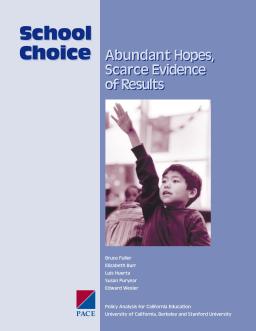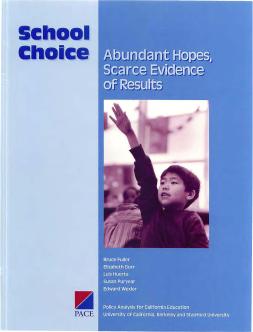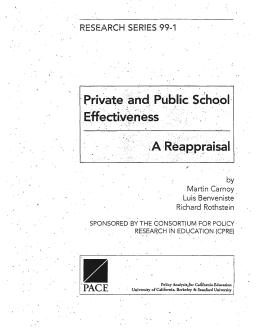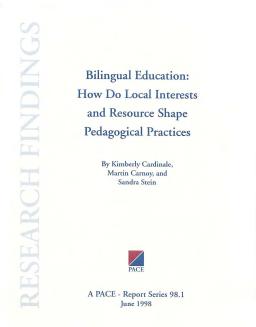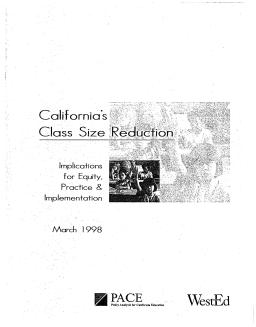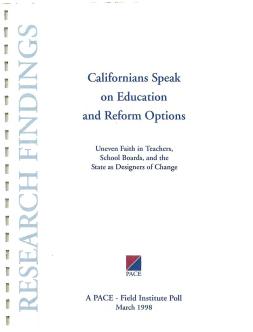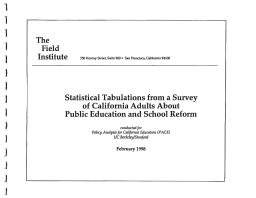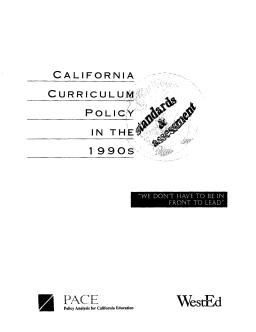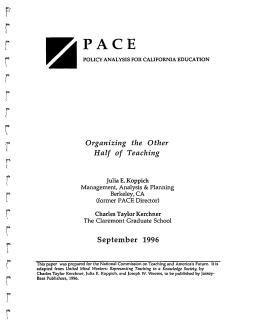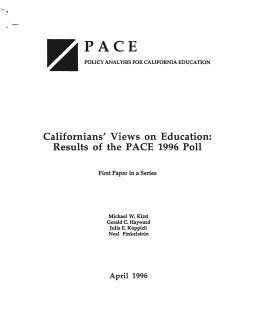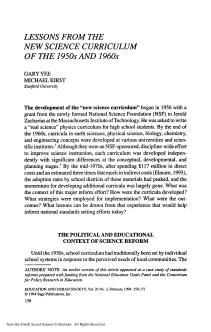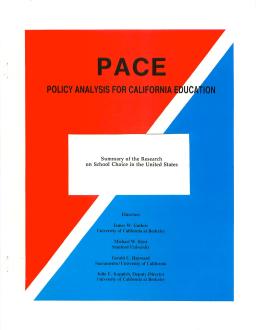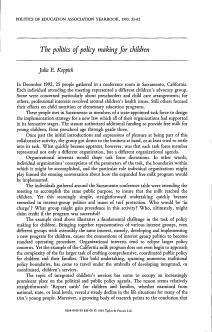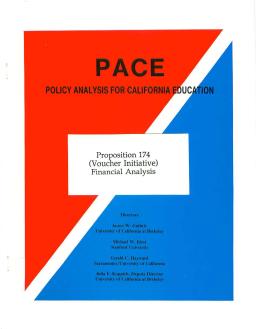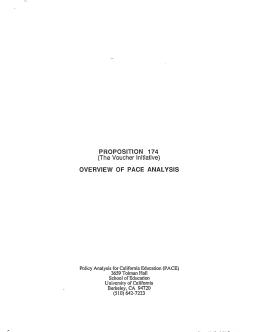Abundant Hopes, Scarce Evidence of Results—Executive Summary
Published
Summary
Public education in the US is widely criticized and everyone wants to reform it, but there's no consensus on the best strategy for improvement. This report focuses on school choice, a reform avenue gaining steam in California and the US, to explore policies and institutional changes that can boost children's learning.
Abundant Hopes, Scarce Evidence of Results
Published
Summary
Public education receives criticism from various stakeholders. Despite satisfaction with local elementary schools, overall quality concerns prevail. There is no consensus on the best approach to improve schools. PACE report investigates school choice, which is a reform strategy gaining popularity in California and beyond.
A Reappraisal
Published
Summary
This report challenges the belief that public schools are ineffective due to a lack of accountability for producing high academic achievement. Some argue that private management is necessary for improvement, but this report seeks to analyze the range of responses that schools have to accountability and determine whether market forces are necessary for improvement.
How Do Local Interests and Resources Shape Pedagogical Practices?
Published
Summary
Bilingual education implementation varies by district due to discourse and policies. Four issues affecting implementation are teacher recruitment, "ghettoization" of bilingual education, race relations, and community consensus. National debates impact local administrative actions, defining bilingual education practice. The report analyzed four California school districts to show the impact of these four issues on program design.
A Study of Eight States and the District of Columbia
Published
Summary
This report presents the results of a study investigating the impact of charter schools on school districts, how they responded, and whether they experienced systemic change due to charter laws. The study focused on eight US states and the District of Columbia and included case studies of 25 affected school districts. The research was funded by The Saint Paul Foundation and conducted in 1997, six years into the charter school experiment. PACE hosted the study.
Implications for Equity, Practice, and Implementation
Published
Summary
In 1996, CA launched a $1 billion class size reduction (CSR) initiative to improve early literacy. The initiative provides $800 per student to schools reducing class size to 20 or fewer in first, second, and/or third grade, and kindergarten. CSR was funded due to a state revenue surplus and the belief that smaller classes would enhance early literacy. CA ranked second to last in national reading tests in 1994, and class sizes averaged around 28.6 students per K-3 classroom. While educators and the public show enthusiasm, the success of CSR in enhancing academic achievement is yet to be seen.
Uneven Faith in Teachers, School Boards, and the State as Designers of Change
Published
Summary
Public education quality has long been debated, worrying parents, activists, and politicians. Recent polls show it is a top concern in California and the US. Politicians and activists propose school reform, and a new election season has begun. PACE and the Field Institute surveyed 1,003 Californians in February to assess their views on education quality, trusted reformers, and evaluating major proposals. The report details key findings.
Published
Summary
This volume presents the results of a PACE survey conducted by The Field Institute among 1,003 California adults via random digit dialing. Statistical weights were developed to match the sample of California adults interviewed to known parameters of the adult population. Estimates of sampling error from results based on the overall adult public sample are +/- 3 percentage points. Other possible sources of error include differences in question wording, sequencing, or undetected errors or omissions in sampling, interviewing, or data processing. The study professionals minimized such errors.
California Families Face Gaps in Preschool and Child Care Availability
Published
Summary
This report highlights the unequal distribution of preschool and childcare opportunities in California. Despite spending $1.2 billion annually, half of preschool-age children live in households with working mothers, with enrollment dependent on income and location. Counties vary greatly in their supply, with affluent parents more likely to find preschool or childcare slots. Latino children are hit hardest, even in counties with ample supply, with supply in predominantly Latino areas half that of low-income Black or Anglo communities.
Standards and Assessments
Published
Summary
This study traces California's curriculum-related reforms in mathematics and science during the 1990s, examining the role of the California Department of Education and the state's shifting political and policy context. It analyzes the perceptions of state officials, experts, and the public and how they influenced state policy changes. The authors raise questions about problems associated with curriculum policy in California and presents policy recommendations mentioned during interviews and document analysis. The study does not assess the impact of curriculum on school practice.
Published
Summary
The 1975 Rodda Act, also known as the Education Employment Relations Act, allowed California public school teachers to collectively bargain for employment terms. Similar laws exist in 37 states based on the National Labor Relations Act. This paper advocates for transforming education labor relations to position teachers and unions as leaders in creating a 21st century education institution. The authors hope to inform discussions on improving education quality for California's 5.2 million public school students.
Results of the PACE 1996 Poll
Published
Summary
A 1996 statewide poll by PACE surveyed Californians on their views and expectations for public schools, informing policy discussions. Results revealed four broad themes and their relevance to ongoing education policy discussions, such as redesigning statewide assessments, reforming traditional school governance, providing public funds for private schools, and complex issues of local control. PACE believes public perceptions should be considered in policy discussions, although education policy should not be solely based on public opinion polls.
Published
Summary
Intergovernmental relations in education policy are dominated by regulations, programs, and technical assistance. A metaphor called "ecology of games" captures how each level of government maximizes its influence, affecting state and local policy-making. Classroom practice is limitedly influenced by intergovernmental policy, as local demands, taxes, and needs also play a role. State policies are easier to influence administrators than to change teaching. Each level of government tries to maximize its sphere of influence.
Published
Summary
This is the ninth edition of Conditions of Education in California. In this volume, PACE has compiled information on current critical issues in state education policy and presented them within the context of major policy developments. "Evolving Context" introduces the current issues in the state and sets the stage for the remaining chapters, which are Assessment and Achievement, Finance, Teachers and Teaching, Integrated Children's Services, Child Care and Development Services, and School-to-Work.
Published
Summary
The National Science Foundation granted MIT's Jerold Zacharias in 1956 to develop a real science physics curriculum for high school students. By the 1970s, curricula were developed in various sciences, but each independently with differences in development, planning, and concepts. Despite the $117 million cost, adoption rates peaked and momentum for further curricula development waned. Lessons can be drawn from this experience to inform national standards today.
Published
Summary
The research base for understanding and prescribing policy for school boards is limited due to the large number of boards and members. Common school boards, especially those of small districts, are less researched. To address this, overall trends affecting most boards should be analyzed to determine the need for and direction of school board reform. Waiting for representative data on all boards will delay improvements to policy making. Major changes in school board roles, functions, and operations are necessary due to the interaction of these trends.
Published
Summary
This report provides an overview of private schools in California as of 1992–1993, examining their enrollment, types, size, geographic distribution, and regulatory environment. It also considers how existing private schools might respond to increased demand if Proposition 174 —a school voucher initiative—were enacted. Under Proposition 174, private schools enrolling 25 or more students and meeting existing legal requirements could redeem vouchers for tuition payments. Private schools enrolled nearly 10 percent of California’s K–12 students, with approximately 554,000 students attending 3,839...
Published
Summary
The paper provides a synthesis of existing literature on school choice, with a focus on research that informs public policy development and evaluation. It presents information without taking a position for or against school choice and is intended for policymakers, parents, educators, and the public. The paper covers six sections, including types of school choice programs, efficacy, economic theories, private schools, public opinion, and unresolved research questions.
Published
Summary
The US public education system has served the nation well, but it must now face unprecedented challenges and worldwide competition. The strengths and weaknesses of the system need to be assessed to build on its strengths and address its weaknesses. However, questions remain about the resources and political will necessary to get the job done.
Published
Summary
The article discusses the importance of parent involvement in education and its effects on student achievement. It suggests that schools need to create a welcoming environment for parents and engage them in meaningful ways, such as through volunteering and decision-making committees. Additionally, the article emphasizes the need for schools to provide information and resources to parents, especially those who are disadvantaged, to ensure that they are equipped to support their children's learning at home.
Published
Summary
The politics of policy making for children is complex due to the multiple interest groups involved. Fragmented policies exacerbate the problem of declining life situations for children. A comprehensive children's policy is needed, but traditional interest-group approaches to policy development must shift to integrate services for children. California's politics of children's policy is briefly explored. The current political paradigm must fundamentally change to open policy doors for broad-based integrated services for children.
Financial Analysis
Published
Summary
The Californians will vote on Proposition 174 which will amend the state constitution to establish "scholarships" for kindergarten to 12th-grade schooling. These new schools will be publicly funded but may have privately selected governing boards and religious orientation. It is unclear whether they will be public or private schools. The paper attempts to reduce uncertainty regarding the financial consequences of the proposed voucher plan and address questions about public costs and possible cost savings.
Overview of PACE Analysis
Published
Summary
Policy Analysis for California Education (PACE) has analyzed the financial, legal, and social ramifications of Proposition 174, the school choice initiative, to provide Californians and policymakers with accurate, unbiased information. This brief contains important questions and answers about the initiative, summaries of PACE's financial analysis and polling report, and background information on PACE and its directors. PACE has published five separate analyses of Proposition 174, covering financial impacts, legal considerations, public opinion, and comparisons with other school choice efforts...
The School Voucher Initiative
Published
Summary
The "Parental Choice in Education Initiative" or Proposition 174, will be voted on by Californians on November 2, 1993. PACE has conducted an analysis of the initiative's provisions to provide objective information to policymakers, parents, educators, and the public. PACE is not taking a stance on the initiative but has produced additional materials related to the initiative and the issue of school choice. These materials are listed in the attached report on school choice.
Published
Summary
California's education reform strategy includes creating high-quality curriculum frameworks to upgrade K-12 education, which raise expectations for students' knowledge and understanding of language arts, mathematics, science, and history/social science. The frameworks focus on learning for understanding, problem-solving, and applying knowledge to real-life situations. The goals are to produce students who know how to learn, analyze issues, solve problems, and apply their knowledge to real-world problems.
